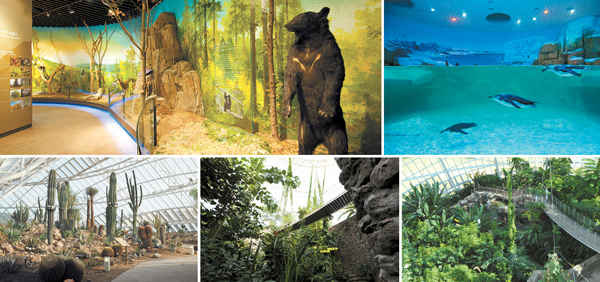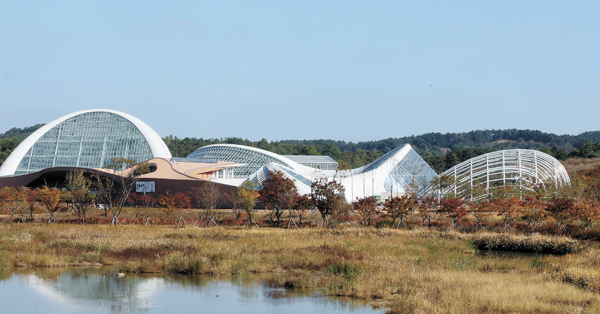Creating a climate for ecology at Ecoplex

The Ecoplex in Seocheon County, South Chungcheong, consists of five exhibitions showcasing five different climates. Clockwise from top left: polar zone with a crescent moon bear, polar zone with penguins, tropical zone, Mediterranean zone and desert zone. By Kang Jung-hyun
The National Institute of Ecology, an affiliate of the Ministry of Environment, designed the Ecoplex ecological park on 998,000 square meters (247 acres) of land, about the size of 92 football stadiums. The park does not open until next year, but the impressive Ecorium building - built by Grimshaw Architects and Samoo Architects and Engineers - is open for early viewing for a few people through an online application.
The Ecorium complex covers 21,932 square meters and consists of five exhibition halls, each one showcasing a different climate.
By way of comparison, the Eden Project in Cornwall in the United Kingdom, which is the world’s largest collection of plants from all around the world, is 23,000 square meters, just slightly larger.
Ecorium: Journey to five worlds
Because each climate zone in the Ecorium is overwhelmingly huge, moving from zone to zone is almost like crossing the borders between small countries.
The most impressive zone is the tropical because it is the tallest glass building in the whole complex, towering over the rest of the buildings.
“The tropical zone stands 35 meters tall because the sacred fig trees [one of the main trees in the zone] usually grow to 30 or 40 meters,” said Oh Chang-ho, a technical expert responsible for caring for the plants in the Ecoplex. “The sacred fig trees are just 5-meters tall now but will reach 30 meters in 10 years.”
Inside the toasty tropical zone, lush greenery and tall tropical trees nearly hit the ceiling of the greenhouse, which is about the same height as a 12-story apartment building. Rainbow-colored tropical fish of various sizes swim in schools in the water and a Burmese python sticks out its tongues in its living quarters. Recorded sounds of tropical birds waft through the air. The tropical zone truly is a jungle.
The tropical fishes and giant snakes are just some of the 7,942 animals from the 240 species kept in the Ecoplex. It also has 1.1 million trees from 4,865 species.
“The biggest characteristic of the Ecorium is that it is a place where animals and plants coexist,” said Yang Ho-je, who heads the public relations team of the institute.
Indeed, numerous plants and animals share the space in each exhibition.
In the desert zone, Australian frill-necked lizards and black-tailed prairie dogs are on display, along with all sorts of cacti. While over in the polar zone, penguins frolic in the pool. Over in the Mediterranean zone, Baobab trees from both Africa and Australia are on display, as well as several types of carnivorous plants.
Another interesting zone at the Ecorium is the temperate zone, which reproduces the Gotjawal Forest of Jeju Island. The forest, found all around the rocky parts of Jeju, is well known for its unique ecological system, which mixes tropical, temperate and cool plants.
Amid the mixture of trees and plants, about 20 wild chickadees catch the attention of visitors. These uncaged birds fly freely from this tree to that tree.
“They are wild birds but not afraid of human beings,” said Kim Du-hwan, another technical expert who is responsible of caring for animals at the Ecoplex. “In addition, these birds do not usually fly into the glass. They also easily develop bonds with people. That’s why we set them loose.”
Some people might be concerned that the animals could gnaw on the plants or otherwise harm them, but Oh, the technical expert for plants, said not to worry.
“Looking at the Ecorium from an ecological perspective, this should be a place where plants and animals live together,” he said. “Bugs would live on plants and birds would peck on those insects in the wild. Then they would excrete. That’s how an ecosystem works.”

The exterior of the Ecorium building at the Ecoplex, home of the National Institute of Ecology in Seocheon, South Chungcheong.
Outside the streamlined Ecorium building, the Ecoplex also offers a lot more to see.
Of the many attractions, the Wetland and Yonghwasil Pond are emblematic of the spirit the Ecoplex wants to preserve. Both areas were there even before the construction of the Ecoplex started, providing shelter for hundreds of plants and animals.
For instance, about 85 types of plants grow in the Wetland, while the Yonghwasil Pond, which is about 120 years old, is home to a great diversity of birds. Spot-billed ducks dwell at the pond all throughout the year and Mandarin ducks, which have been designated as national treasures, also visit the pond during the winter along with other migratory birds.
The National Institute of Ecology took care to observe the characteristics of the local terrain when it chose the site for the Ecoplex.
In addition to the Wetland and the pond, the forests surrounding the Ecorium are also quite fascinating.
The Korean Peninsula Forest features trees native to Korea, including local varieties of camellias, pines, oaks and firs.
Right next to the Korean Peninsula Forest is the High Mountain Garden, which features plants that are only found in high, mountainous areas, like around Mount Jiri, Halla and Seorak. In order to keep temperatures low, which would be found high on a mountain, the garden is equipped with an underground water circulation system.
Every nook and cranny of the Ecoplex is close to nature, but it wasn’t easy at all to prepare the huge facility.
The institute began importing trees from overseas in July 2011 and spent a whole year transplanting all the trees. Thirty percent of the trees had to be discarded even before they were planted because quarantine required they be imported without a trace of soil.
Bringing in the animals to the Ecoplex was another daunting task. Just for the penguins, institute officials had to fly to Japan and stay there two weeks to become acquainted with them.

The exterior of the Ecorium building at the Ecoplex, home of the National Institute of Ecology in Seocheon, South Chungcheong.
The opening of the Ecoplex is meaningful in a way beyond just being a beautiful place to take in the natural wonders from around the world. It also is linked with the local economy of Seocheon.
The Ecoplex project dates back to 1989, when the government designated the sea area around Gunsan and Seocheon as national industrial complexes. The sea by Gunsan was reclaimed, but the same project for Seocheon County was postponed because of environmental issues.
That delay lasted 18 years, while angry citizens demonstrated in 2006, trying to get the industrial project restarted. The county governor at the time even went on a fast and students stopped going to school to attend the angry rallies.
Eventually, to make up for the cancelled development project, the Ministry of Environment and other six ministries promised to build the National Institute of Ecology and another national institute for marine animals in Seocheon.
Choe Jae-chun, a professor of ecoscience at Ewha Womans University, took the helm of the institute.
Choe, a renowned behavioral ecologist, stressed the importance of developing the institute into a hub for ecology.
“In order to make the institute boost the local economy of Seocheon, the institute should grow into an international research and exhibition center,” said Choe.
The official opening is early next year, but people who wish to look around the Ecoplex before that can sign up online. No admission fee is charged until February.
For further information, you can visit www.nie.re.kr (Korean only) or call (041) 950-5339.
BY KANG CHAN-SOO [so@joongang.co.kr]










with the Korea JoongAng Daily
To write comments, please log in to one of the accounts.
Standards Board Policy (0/250자)